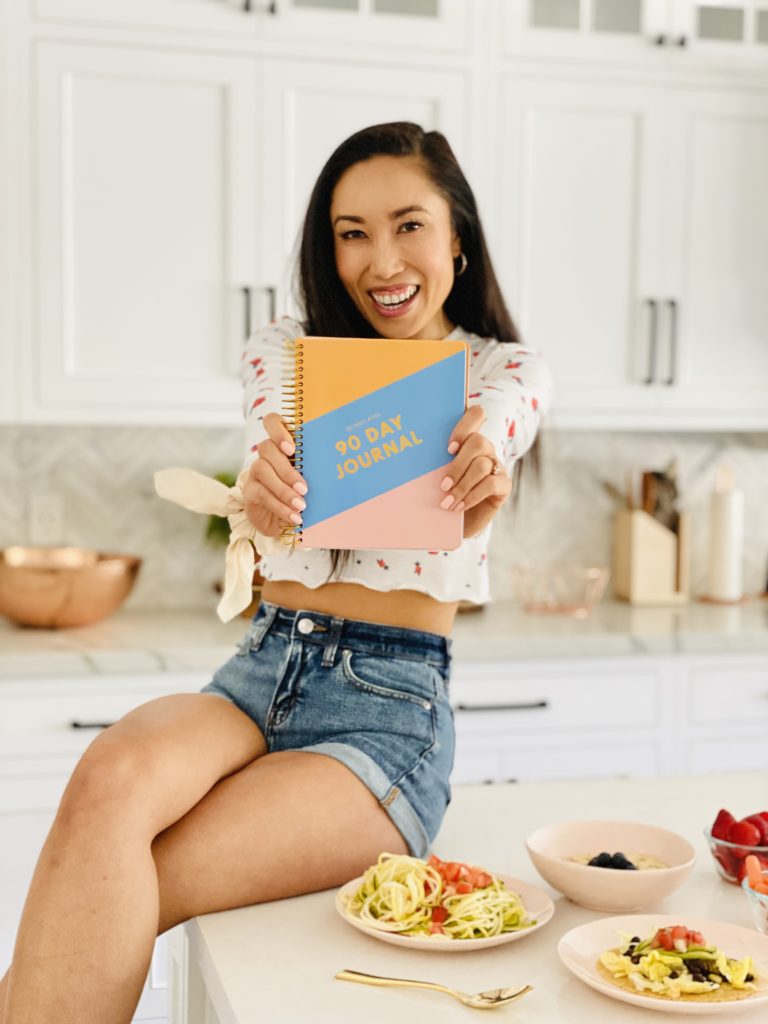Your Ultimate Guide to Measuring and Understanding Portion Sizes
Hey guys!
A few weeks ago, I made a post on the BODY By Blogilates IG about portion sizes. It brought up A LOT of questions so I thought we’d talk about it more here! Have you ever wondered where portion sizes come from, or how they’re different from serving sizes? Or if measuring either one is really necessary?
First, let’s talk about portions vs. servings. As defined by the USDA:
Serving = A standardized amount of food, used on nutrition labels. These are usually based on “recommended amounts.”
Portion = The amount of food YOU choose to eat.
So let’s apply that to one of my favorite foods, ice cream! If you look on a nutrition label, the SERVING size is 1/2 cup. But you know I’m scooping at least 1 cup, and that would be my PORTION size.
Okay, but which one should we use to plan meals? Both? Neither? Let’s find out.

How to use portion sizes
How can we use portion sizes in a healthy way? First – should your portion size always match the serving size listed on the nutrition label?
It doesn’t have to! The label is just a guide. It’s there to help you estimate the calories, macronutrients, vitamins and minerals you’re getting from your food and to give you an idea of how much the average person should eat, based on USDA recommendations.
Simply being aware of what a serving looks like can help you portion your foods appropriately. It doesn’t have to be a strict thing where you measure everything you put on your plate though! I like to think of it as a tool to portion foods according to my needs and goals.
Also! I found it suuuuuper helpful when I learned to eyeball what common portion sizes like a cup or tablespoon looks like. I use this to measure portions and even when I’m cooking or meal prepping.
Here are some tricks I use to measure portion sizes!
When portion control is your goal
Portion control is a struggle. Soooo many people say it’s hard to avoid overeating certain foods, which just makes them feel uncomfortable later. THIS is where estimating your portions can help.
It’s not about restriction or meticulously measuring everything you eat. It’s about balancing your meals, satisfying your cravings, and decreasing the chances that you’ll overdo it and feel bloated and uncomfortable later.
Instead of sitting down on the couch with a bag of chips, estimate a portion with two hands. When you’re dipping out some ice cream, do it mindfully by eyeballing a portion about the size of your palm. Or two portions if you really love ice cream like I do 😉
The point is to KNOW what you’re eating, instead of mindlessly eating more than you really want into a bowl.
If you eat your portion and still feeling hungry or want more, you can absolutely honor that!

When you’re tracking macros
If you choose to track macros for your personal goals, it’s sooooooo helpful to know what a serving looks like. Here are some examples.
Protein – 3 oz is about the size of a deck of cards, or the palm of your hand. A 3 oz serving is ~21g protein.
Fat – A teaspoon is about the size of your thumbnail. One teaspoon serving is ~5g fat.
It’s common to use a Tablespoon serving for fats as well, which is about the size of your thumb.
Carbs – This depends on the food. For things like pasta, rice and cereal, you can use a scooped handful to measure about 1/2 cup. It’s also about the size of a tennis ball! For fruits and veggies, the size of a fist or baseball will give you a 1 cup serving.
Again, is it “bad” to eat more than the serving size? NOPE. The point is to use the serving size to create the best portion size for YOU.

When you’re cooking and meal prepping
I think cooking taught me the most about serving sizes! I haaaaaate getting a bunch of dishes and measuring spoons dirty, and my cooking style is kinda just throwing together ingredients that sound good. So learning to eyeball ingredient measurements totally changed my cooking game.
Obviously, this won’t work for everything (I learned the hard way that baking is pretty specific), but WOW learning to eyeball some common measurements has been a serious time saver.
The same trick probably saves serious time with meal prep too. Portioning out your meals ahead of time saves you from cooking all week long and it makes healthy meals available and ready to eat! From my experience, that means you’re more like to EAT them, vs. graze in your pantry while trying to decide what to eat (I am sooo guilty of this).
Final thoughts – use portions as a guide, not a strict rule
Hopefully this little guide helps you see how portion sizes are helpful without adding rules or restrictions to your diet.
Serving sizes are just recommendations, and each of us has very different needs. Let the recommendations serve as a tool to ultimately measure the portion of food YOU need to meet YOUR goals!



























6 thoughts on “Your Ultimate Guide to Measuring and Understanding Portion Sizes”
There are Array6 comments posted by our users.
Dear Cassey,
I used to do your workouts all the time, and loved doing them, but I stopped once school started getting really busy. Now that it’s summer, I’ve been trying to get back into the habit, but even though I’m doing beginner workouts, I’m barely making it through. I’m worried that I won’t ever get back to the joy that working out brought me because I can barely do a workout! Help!
Hi! I’m not Cassey, but i have followed her workouts for a long time. I used to follow the calendar and follow the workouts on there every day. I did this for 1.5 years maybe, but school and social time got in the way so i fell off. I am trying to get back into working out, but get demotivated by doing the same videos since i know i was able to get so much further before! My way of getting some workouts in is going to the gym! I used to fear the gym so much, but find someone you trust to go with you so you don’t feel like people look at you if you’re scared. I find that instead of following Cassey everyday now, i love doing her new workouts and videos and some here and there, but switch it up with other YouTubers, or just workout programs in the gym! I hope this can help some. Challenging yourself may be easier there, and also tracking progress if you’re not completely new to working out anymore 🙂 Good luck!
This was super helpful! Thanks so much Cassey <3
Wow this was so helpful! Thank you 🙂
Thanks a lot Cassey for this amazing post!
Dear Cassey, should teens be trying to have a calorie deficit in order to lose fat and gain muscle, or is that dangerous? For reference I am a 14 year old girl (I haven’t gotten my period yet either) and my mom says I have to be eating what I’m burning (no deficit) or more than that because I am in a developmental stage. Since you often talk about this topic, I thought you might be able to help me and those in similar situations figure out a healthy plan to get stronger?
– Confused teen